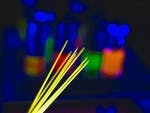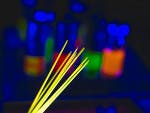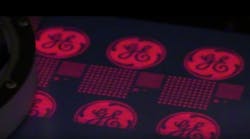While LED makers have made great strides in the efficacy of white LEDs, the products still don't output pure warm white light that's comparable to other technologies. Quantum-dot technology, however, can serve to improve light quality in both LED-based backlight and general illumination applications.
A number of startup companies around the globe are developing quantum-dot technology for applications ranging from lighting to military to biotech. Nanosys and QD Vision are poised to enable consumer products that will come to market this year.
Nanosys recently announced that LG would deliver mobile products with quantum-dot-enabled, LED-backlit displays. And QD Vision is supplying an enabling optical component called the Quantum Light optic to Nexxus Lighting for LED-based light bulbs.
Quantum dots are semiconductors with a crystalline structure. When stimulated by photons, the crystals emit light with the color being determined by the size of the crystal. So quantum dots can produce any color in the visible light spectrum -- unlike LEDs where both white and green light are problematic.
QD Vision chose to initially target the illumination market because the company foresaw a ready market. Co-founder and CTO Seth Coe-Sullivan stated, "The lighting market is extremely fragmented. We saw a handful of small innovative companies that were ready to move forward with us." Coe points out that the backlight market has far fewer players and moves more slowly in adopting new technology for extremely high-volume consumer products.
For companies such as Nexxus, QD Vision will supply an optical lens-like product that's coated on the inside with quantum dots – essentially a phosphor coating. The Quantum Light optic will enable bulbs with the energy-efficiency and long-life benefits that LEDs offer along with warm white light.
The quantum-dot application is a bit more complex in backlighting. LCD display pixels are actually made up of red, green, and blue sub pixels. Each sub pixel is essentially a filter that only allows a relatively narrow band of wavelengths to pass. The backlight must be a broad-spectrum source that covers the red, green, and blue bands.
Backlight sources such as CCFL lights have no problem generating the required light spectrum. But products are rapidly moving to LED backlights for energy savings and even the ability to do local dimming in HDTV applications.
While LEDs have garnered headlines recently in TVs, the technology isn't perfect. Jason Hartlove, CEO of Nanosys, points out that the white LEDs used in backlight applications don't output much power in the red portion of the visible light spectrum. Hartlove said, "You get a pinkish orange rather than a deep red."
Hartlove acknowledges that the LCD HDTVs that rely on a matrix of LEDs covering the entire screen can overcome the problem by using red, green, and blue LEDs. But he also points out that such TVs employ upwards of 1000 LEDs that cost "some fraction of a dollar each."
Quantum dots can both improve the quality of LED backlighting and lower costs according to Hartlove. He said, "Our manufacturing process yields the ability to emit specific wavelengths allowing you to exactly match the color requirements of the application."
Nanosys will supply its technology in the form of a QuantumRail optic that sits between the LEDs and the light guide that channels the light to the screen. Hartlove stated, "We can create a backlight from a single emission source such as a blue LED." Indeed blue LEDs are extremely efficient and the blue light excites the QuantumRail to produce the red, green, and blue wavelengths required by the LCD filters.
LG has yet to announce a product using the Nanosys technology, but Hartlove predicts it will happen this year. The first product will be mobile in nature – that means it could be a notebook PC or a mobile handset. Handsets have moved exclusively to LED backlighting and the notebook market is quickly headed in that direction.






